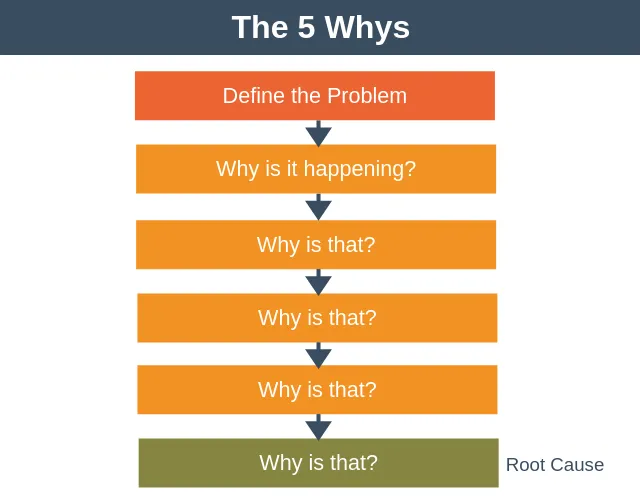Session 6: Solving Problems As a Supervisor
In this session we will explore strategies to recognise and solve problems that may arise within a project or an organisation. We will then spend some time discussing time management and how to best prioritise tasks. We will review tools that you can use to analyse problems and more efficiently manage your time and priorities.
Getting Ready For This Session
- Remember to have your workbook and a pen or pencil handy.
- You will need about 95–100 minutes to complete the session.
Learning Objectives
By the end of this session, you will be able to:
- Identify the root causes of problems in teams and work
- Explain the importance of resolving problems in a timely manner
- Demonstrate ways to effectively engage team members in problem-solving tasks
- Describe the steps in the problem-solving process
- Develop the skills and ability to efficiently manage time and prioritise tasks
Learning Activities
-
Introduction (2 min)

Welcome to Session 6!
In this session we will explore steps that you can use to solve individual and team problems in the workplace. We will also review strategies you can use to efficiently manage your time and prioritise tasks. Let’s get started!
-
Pre-Session Assessment (5 min)
Let’s start off with a quick check of your knowledge and comfort about solving problems as a supervisor. Each question will have a score for you to track in your workbook. Please track your scores as you go through this assessment, and make note of any content areas that you answered incorrectly. This exercise will help to identify gaps in knowledge and areas that need more attention as you go through the content in this session.
-
Problem-Solving in the Workplace (5 min)
Problem-solving is a critical supervisory skill. It can simply be defined as identifying solutions for a particular problem. Problem-solving strategies allow us to evaluate the current situation, figure out what we want to change, and identify what needs to be done to accomplish the desired outcome. This session will focus on problem-solving within projects, but you can also use problem-solving skills in other situations, such as managing conflicts between team members.
In this session you will have the opportunity to apply all that you have learned throughout this training. Effectively identifying and addressing problems requires clear communication skills, the ability to coach others, support effective team dynamics, and provide and receive feedback. In Session 3, you learned about using the GROWS model to support your ability to coach your team members. There are many similarities between the GROWS model and the problem-solving strategy used in this session. This problem-solving strategy also guides you through defining your overall goal, identifying the current situation, determining the options, deciding on a solution, and supporting implementation of that solution.
Within any industry, you can expect problems to occur in the workplace. For example, you may find a shipment of necessary medical supplies has gone missing or frequent staffing shortages. You can also use your problem-solving skills to anticipate potential problems and implement solutions to mitigate them or prevent them from happening.
No matter what the problem, there are clear strategies you can use to address them. Using established strategies can help you identify solutions in a timely manner. It is important to promptly address problems, because that will help you to stay on track and keep them from growing out of control.
Problem-solving in health care settings overlaps with the concepts of Quality Improvement (QI). You may have already had some training or experience with formal QI projects and activities. In this session, we will frame our discussion using a model described by Massoud et al. (2021), which involves four types of problem-solving: individual, rapid team, systematic team, and process improvement. For this session, we will focus on individual and rapid team problem-solving, which are useful models for addressing less-complex problems. (For more information on QI, take the ‘How to Be a QI Coach’ course.)
The problem-solving strategy you choose will depend on the problem you have identified. However, you can expect that in every situation you will:
- Define the problem
- Identify solutions
- Choose a solution
- Implement the chosen solution
- Evaluate progress and make adjustments
-
Past Problems Solved (5 min)
-
Rapid Team Problem-Solving and Analysis (10 min)
Individual problem-solving strategies work best when you can successfully address the issue without a team. Although there is value working in a team, there are also situations that require one person to quickly identify a problem and find a solution. You may choose to solve a problem on your own when you are responsible for the specific task, or if you have the knowledge and time to promptly address the problem.
Rapid team problem-solving strategies work well when a team needs quick results, has some understanding of the issue, and has ideas for how to proceed.
You can use the following steps on your own or with your team to anticipate problems before they happen, or to solve them once they occur1. Click or tap on the boxes below to learn more about each step:
Define the problem
Recognise that there may be several issues creating the overall problem. Begin by evaluating the situation. To do this, focus on the facts to identify where in the process the problem is occurring. Review any necessary information that may be helpful. Once you have a better idea, use specific language to define the problem—such as, ‘the standard operating procedures (SOPs) are not clear, making it confusing to proceed with process.’
Once you define the problem, you can also quickly understand why it exists by using the ‘5 Whys.’ This is a great tool to use before developing a solution, as it allows you to dive deep into the problem.

When using the 5 Whys, you first want to describe the problem. Consider what happened or has been happening. Then, ask why it happened or has been happening. You can keep asking why until you identify the root cause of the problem. This process may involve more or less than five whys. Once you complete this analysis, you can evaluate the steps you need to take to achieve your desired results.
You can also use the Fishbone diagram. This is a great tool to use when there are several factors or circumstances that may be causing the problem. You can find the Fishbone diagram in the resources section at the end of the session.
Identify solutions
Consider all the possible ways to solve the problem you have identified. You may write the identified solutions out on paper to more effectively review all the options.
Choose a solution
Once you identify possible solutions, look to see what resources are needed to put each one into action. Consider the time it would take and the information you may need. If you are working in a team, you can also discuss who would be needed to implement the solution. After you consider your options, choose the solution that will require the fewest resources and provide the most success.
Implement the chosen solution
Once you define the problem, identify and choose a solution, you may be able to implement the strategy quickly. For example, if you learn that certain medical supplies are out of stock in the clinic, you can call NatPharm to find out how to expedite delivery. Some problems may require more effort. Consider creating a brief action plan with objectives, measurable targets, timelines, and clear tasks.
Evaluate progress and make necessary adjustments
When you have your solution in place, it is important to evaluate whether it will help you reach your desired outcomes. You want to ensure that the solution will work, so you may need to make adjustments as you go along or come up with alternative solutions. Again, you can do this step on your own or with your team.
When problem-solving with your team, make sure that everyone has a clear understanding of their roles and responsibilities. You learned more about this in Session 4, Team Dynamics. You may also need to return to some of these steps more than once during your problem-solving process.
-
New Ideas for Your Old Problem (5 min)
-
Best Problem-Solving Strategies (5 min)
Now that you have reviewed the problem-solving process, let’s listen to Romana Katekwe share her best practices for solving problems in the workplace.
Transcript

Hi, my name is Romana Katekwe. Many of you know me as the Zim-TTECH Senior Quality Improvement Officer. As a regular part of QI work, we spend a lot of time looking at problems and identifying how to make changes that will benefit the facilities, teams, and clients. The first thing that I do to begin solving a problem is clear my head. I take a few deep breaths and try to step back so that I can look at the whole picture. It helps to calm my mind so that I can focus on the problem at hand. It is important to remain objective when problem-solving. I shut off my feelings and my multi-tasking brain. I try to think about what the issue is and what is [at] the core of it. Once I am clear about the actual problem, I try to think about solutions that I know have already been tried—why re-invent the wheel?—and then I try to be creative in my thinking and go outside the box.
Whenever possible, I try to come up with some solutions that are aspirational. I do this whether I am addressing my own problems or facilitating a group to work through possible solutions. Once there are some ideas generated, then it is time to review and see which may be feasible; it could be a combination of the really creative with the very simple solutions. Once there is a feasible solution, it is time to think about how to implement it and how it will be measured. It sounds straightforward, but in reality this can be complicated. That is where staying objective helps—not just in defining the problem, but I try to remain objective throughout every stage of the process. In true QI fashion, I try to make sure that solutions are tested, documented, and adjusted as we go. And I always try to find a way to celebrate success, even if it is just an acknowledgement to myself for personal problem-solving—but most definitely with teams, I just like to let them know when something has worked.
Romana -
Time Management (5 min)
The rest of this session will focus on time management and task prioritisation. Both skills are a form of problem-solving, and are essential skills to support your overall success as both a supervisor and an employee. Although your problem-solving and critical thinking skills can help you effectively manage competing tasks and your time, there are also other tools you can use.
Effective time management and task prioritisation skills help you to work smarter, not harder. Working smart means that you are working hard, but are also working efficiently and effectively. The tools you will learn will allow you to make better use of your work time. You can use these tools for yourself and share them with your team members.
-
Your Time Management (5 min)
Reflecting on your personal time management skills overall:
-
Strategies for Effective Time Management (8 min)

Using effective time management skills gives you the opportunity to plan and control the time you spend on certain activities. There are many benefits to strong time management skills. Practicing these skills:
- Keeps you organised
- Prevents missed deadlines
- Reduces stress levels
- Increases productivity
- Enhances the quality of work
You may notice that your time management abilities change over time. A specific project, team, or environment can affect your readiness and time management strategies. Certain life events may also prevent you from effectively managing the time you spend on project tasks. However, it is important to create a time management regime or toolbox to establish skills that you can readily rely on. This section will walk through some tools you can put in your toolbox.
Take a moment to listen to Girija Vaidyanathan share best practices for managing your time well.
Transcript
One is to delegate appropriately. The second is to not take on extraneous work, as far as possible. Things like functions, things like visitors who are not adding value. I think the trick is to try to manage them within appointed times—that is, set yourself some time a week for doing that, because that will still happen. But don’t try to exceed that. That we managed very well. I was able to manage that better than not looking at detail. And the third I think would be to keep focus on what are your objectives. If you’re looking at your objectives clearly, I think your time can be managed quite well.
Girija VaidyanathanLet’s review the best practices from the video:
- Delegate appropriately
- Refrain from extraneous work tasks when possible
- Focus on your objectives
When managing your time, you can also systematically block your time throughout the day and utilise the 1–3 minute rule as described below.
Block Your Time
One effective time management tool is blocking specific times throughout your day to complete a task. To begin, make a list of all that you’d like to accomplish that day, or during the week. Then, you can block out times throughout the day to work on or finish the tasks you have identified. If you use an online calendar, consider using it to block time in order to hold yourself accountable for completing a specific task, and to let others know that you will be unavailable during that time. Consider blocking out time frames of 30 minutes to one hour. After each one, take a break, and begin again. You may also use a timer to help you track your time. Remember to stay flexible during this process; you may need to readjust and continue creating time blocks to complete your desired tasks.
1–3 Minute Rule
This rule states that if you can complete a task in one to three minutes, do it right away. Utilising the 1–3 minute rule allows you to effectively manage small tasks that can build up throughout the day, such as writing email, sending meeting invitations, or blocking your time for the following day.
Efficiently managing your time takes practice. You may find that one of these tools works better for you than others. You may also use other techniques to manage your time. It is important to identify and do what works best for you. Also remember the principle of quality over quantity. As you manage your time, you also want to ensure the quality of your output, not just the number of tasks you complete.
-
Task Prioritisation (8 min)
Managing your time well is one way to stay organised and focused and to meet deadlines. Now we will focus on task prioritisation. Task prioritisation differs from time management in that it helps you identify tasks that are urgent and important, which allows you to get them done first. Efficiently prioritising your tasks at work can have similar benefits to time management. Using this skill can also:
- Keep you organised
- Prevent missed deadlines
- Reduce stress levels
- Increase productivity

Now let’s review effective task prioritisation tools that can help you be more productive. Because time management and task prioritisation are related, you may find that combining time management and task prioritisation techniques is the most effective approach to achieving sustainable and desirable outcomes.
1–3–5 Rule
This tool focuses on the idea that you can only accomplish one big task, three medium tasks, and five small tasks a day. You can adjust these ratios to align with what is feasible for you. For example, if your day is often spent in meetings, you may only be able to accomplish 1–1–2: one big task, one medium task, and two small tasks. This tool helps you set realistic goals for what you can complete in a specific time frame.
Do What You Dread First
Often the task or activity you do not want to do is the one you avoid. Consider working on this task first. This helps you to complete the task in a timely manner and combat the habit of procrastination when working on a task that is overwhelming or unpleasant. We will talk more about procrastination later in this session.
4 Ds of Time Management (Do, Defer, Delegate, Delete)
This is a great tool to help you organise and manage your time. The 4 Ds of Time Management is similar to the Eisenhower Time Management Matrix tool; both help you to quickly evaluate tasks based on urgency and importance.
Do (Urgent, Important)
Complete what is essential first.
Example: You receive a report that a subordinate has been involved in an accident and there is no one to work in the clinic. There is an urgent need to find a replacement.
Defer (Less Urgent, Important)
Pause work on a task that does not need to be completed right away. Schedule time to work on it in the future.
Example:
- Training of trainers for the project that is not starting until next quarter.
- Reading papers and publications
Delegate (Urgent, Less Important)
You do not need to complete every task yourself. Reassign the task to someone else who has the time and can do it well.
Example:
- Ask an assistant to write the first draft of a report on the site support visit that was conducted the previous week.
- Representation at a Ministry meeting
Delete (Less Urgent, Less Important)
Delete or remove unnecessary tasks from your schedule.
Example: Attending meetings or webinars that seem interesting but are not directly related to your work
You can create and use your own four-square matrix to help you evaluate your tasks. This technique can be done on paper or on the computer. You can use this tool to prioritise day-to-day tasks, or tasks you need to complete over a longer period of time.
4 Ps of Time Management (Planning, Prioritisation, Productivity, Positivity)
The 4 Ps of time management help you create a sustainable routine for efficiently prioritising tasks and managing your time. This process tool helps you work with a strategic and optimistic mindset when organising your time and tasks.
The 4 Ps include:
- Planning: Begin by explicitly defining what needs to get done. If you like lists, you can create a list on a piece of paper. Identify what tasks you need or would like to get done and by when. Set your goals for the day or the week.
- Prioritisation: Once you define what needs to be done and your goals, you can determine which tasks are most urgent and important.
- Productivity: When you begin your tasks, make a goal to be productive and complete the tasks on time.
- Positivity: Plan time to take breaks and celebrate your accomplishments. This can help you stay positive throughout the process.
-
Applying Time Management (5 min)
-
Case Study (10 min)
Returning to our case study with Takudzwa, recall that he provides supervision to four facilities, including the Mwenzi Polyclinic and Mutorashonga Clinic. Although he has been in his role as a District Mentor for four months, he is still figuring out a routine to best provide support to his team members while still completing all his paperwork and documentation. Most recently, Takudzwa expressed feeling overwhelmed and stressed by the number of tasks he needs to complete in the next week.

Takudzwa Takudzwa is planning a site support visit to Mutorashonga Clinic tomorrow. It has been almost two months since his last visit, but he has not been able to have regular conversations with the team due to poor network. The weekly reports are almost always late, and often incomplete. Takudzwa knows he is going to need to address this issue and work with the team to improve the completeness and timeliness of documentation.
Before the visit, he has one day to complete the following tasks:
- Call the nurse in-charge to verify the meeting start time and agenda.
- Review the clinic’s most recent outcome data and print out reports to bring with him to the clinic.
- Follow up on emails in his inbox; he has over 50 unread emails.
- Write an abstract for a conference presentation submission that is due in two months.
- Prepare for an afternoon meeting with his supervisor.
- Prepare the quarterly update report that is due next week.
- Complete his registration for an eLearning course that closes at the end of this week.
- Check responses to a social media post.
-
Dealing With Procrastination (10 min)
Procrastination is ‘the act of delaying or putting off tasks until the last minute, or past their deadline.’2 Procrastination can look like watching random videos, completing household chores, or starting conversations with colleagues when you have a lot of work to do.
It is important to acknowledge that procrastination happens. You may personally deal with procrastination or notice team members who regularly put off tasks. A variety of reasons may cause someone to put off their work, including lack of motivation, feelings of exhaustion, general distractions, and even anxiety. Ultimately, procrastination is about managing emotions, not time. Often, the tasks being avoided provoke a negative emotion in the individual.
Before we discuss strategies to address procrastination, let’s review three general types of procrastinators3:
- Avoiders tend to fear failure and worry what people think about them. They may also experience various emotions, like worry and anxiety, that may or may not be about the task itself. These emotions can alter the outcome of a project, or even prevent someone from getting started.
- Indecisive procrastinators struggle with the amount of work or number of decisions that need to be made. They may not know where to begin so they do not start at all. They may also want to start when everything is in place or ‘perfect’. The desire to be perfect may delay progress.
- Thrill seekers thrive under last-minute pressure and prefer completing tasks with a close deadline. This may be the motivating factor they need to get started.
Reflection:
Although frequent procrastination is detrimental to workplace success, there are actions anyone can take to address this cycle of behaviour. Taking action is the best way to beat procrastination. The time management and task prioritisation tools above can also help overcome regular procrastination. For example, the techniques of completing tasks prioritised as important and urgent and starting with tasks that you can finish in three minutes or less can help you move past procrastination. Let’s review some other strategies to overcome these forms of procrastination:4
- Relax the body and count to 10 in your mind before you start a procrastination behaviour.
- Identify and work during the time of day when you are most productive.
- Remove distractions from your workspace.
- Establish and focus on clear goals.
- Divide large tasks into small, more manageable pieces.
- Reward yourself when you implement your action plan.
It is important to note that individuals who procrastinate can be dedicated, hard-working employees who are overwhelmed and stressed, and therefore put off certain tasks to cope with these feelings. If these feelings are not addressed, the level of stress can increase, causing the cycle of procrastination to continue.
-
Action Plan (10 min)
Using the five steps described for rapid team problem-solving and analysis, list a problem you are experiencing individually that you need to address. Write the problem in your workbook. Complete all five steps. Plan for the implementation and evaluation of steps to address this problem.
-
Post-Session Assessment (5 min)
Now that you have completed this session, let’s take time to check your knowledge and comfort about solving problems as a supervisor. Please track your scores as you go through this assessment, compare them with your pre-test scores, and make note of any content areas where you answered incorrectly.
-
Summary (1 min)
Congratulations on completing the session! We outlined a five-step problem-solving process and reviewed time management and task prioritisation strategies. You also had the opportunity to reflect on your own problem-solving process and time management skills. Great job!
-
Resources
Below are links to resources relevant to this session.
Title/Source File Fishbone Diagram Click to open file.
Footnotes
- Effective Problem-Solving Steps in the Workplace | Indeed
- What Is Procrastination? | verywellmind
- The Psychology of Procrastination & How To Stop Procrastinating | The Friendly Brain (YouTube)
- Why People Procrastinate: The Psychology and Causes of Procrastination | Solving Procrastination



